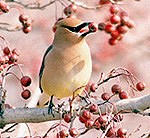

|
In recent years, backyard bird feeding and other nature-related activities have become some of the most popular past times in the United States. Providing bird feeders, bird houses, water and wildlife friendly landscaping can provide hours of enjoyment for you and your family. |
Many birds benefit from trees, shrubs and flowers that are native to Illinois. These plantings provide food and safe nesting places. See the cedar waxwing entry below for an example. Pictured here are some of the birds most likely to be found at feeders and in bird houses in urban and suburban areas. |
 |
 |
 |
| The white-breasted nuthatch can be found in many wooded habitats including your backyard. Watch them come down the tree headfirst. | Blue jays are aggressive and won't back down to potential predators like hawks and owls. | Watch the black-capped chickadees at your feeders as they take a single seed and fly up into the tree where they will pulverize and eat it. |
 |
 |
 |
| The downy woodpecker is the smallest woodpecker in Illinois. The male has a small red spot on the back of his head. For more species of woodpeckers, click here. | Don't be insulted if the American robins don't use your feeders. They are everywhere in cities, but don't normally come to feeders. | Mourning doves thrive in open habitats where they eat waste grain and weed seeds. They are widespread in Illinois. |
 |
 |
 |
| Male house finches have a red head and chest. Females, which are brown and streaked, are often mistaken for female English house sparrows. | The ruby-throated hummingbird is the only hummingbird species that normally nests east of the Mississippi River. For more information and pictures of hummingbirds, click here. | House wrens will take advantage of bird houses provided for them. Remember, larger birds such as European Starlings will take over any birdhouse with an opening greater than 1.5 inches in diameter. Wrens and chickadees only need 1.25 inches. |
 |
 |
 |
| The beautiful northern cardinal sometimes provides the only splash of color during a cold, gray winter. Females are a brownish yellow. They love sunflower and safflower seeds. | Cedar waxwings are a great reason to plant hawthorn, holly or viburnum varieties that produce berries. They get their name from the colored patches on their wings that look like the sealing wax once used to close envelopes. | The common grackle is a native species that thrives in areas disturbed and manipulated by human activity. They gather in large flocks and are seen in both cities and the countryside. Careful timing when mowing fields and ditches can help discourage birds like grackles. Click here for more about mowing's effect. |
 |
 |
 |
| Watch for the American goldfinch (winter plumage) and dark-eyed junco at your winter feeding stations. Goldfinches stay around, they just molt in a drab set of feathers. Juncos are here just for the winter. Learn more about molting here. | The sunny American goldfinch (summer plumage) is a welcome visitor to backyard feeders. The are also seen in prairies, roadsides and forest edges. | The white-throated sparrow is the one true sparrow you are most likely to see browsing on the ground below your feeders in spring and fall. Click here for more about sparrows. |